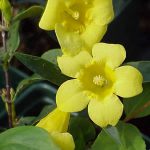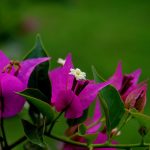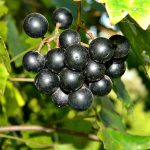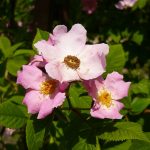Climbing plants like vines and roses lend a lot of charm to an ordinary garden, especially when they’re adorning a pergola, creating a shady garden oasis with lush greenery. Here are five classic climbers that thrive in the Texas heat but are still cold-hearty enough to survive a few days of freezing temperatures.
1. Carolina Jessamine

Native to East Texas, this handsome and compact climber is a truly evergreen flowering vine. Its tubular blossoms are highly fragrant and appear in the spring and fall. Carolina jessamine’s cheerful yellow flowers appear most profusely in full sun, but this plant will also flower in shade. It’s stems will twine on trellises and over pergola supports. Carolina Jessamine can get very top heavy, so it should be pruned back yearly.
Carolina Jessamine is native to the open woodlands with sandy moist soils of East and South Texas, but it adapts well to the heavy clays of the rest of the state, requiring some supplemental water the farther west it is grown from its native habitat.
Bonus: all parts of the Carolina Jessamine plant are poisonous, so you won’t have to worry about deer munching on your foliage.
2. Coral Honeysuckle

Easier to contain compared with other honeysuckle varieties, Coral Honeysuckle is an evergreen vine that produces vibrant red-orange trumpet-shaped blossoms in spring, fall and sometimes winter.
Coral red flowers in mild weather followed by red berries. Evergreen, deciduous in cold winters. Most soils; tolerates poor drainage. Sun to Part shade. This is not the fragrant, but rampant, yellow honeysuckle that will swallow whole yards. This civilized and beautiful vine grows quickly and aggressively, but stays where you want it. It twines, so will need support to get started. Flowers are a beautiful coral red, long, thin trumpet; the interior is yellow and seems to glow. They are not fragrant, but hummingbirds love them and birds appreciate the large red berries that follow. It will need some extra water and shade for its roots if it is grown in full sun. It is native to Dallas County and will grow on limestone, but given deep, rich soil, will grow rapidly into a wonderfully lush vine
3. Bougainvillea

Bougainvillea is a showy bloomer from early summer through fall. Bougainvillea can tolerate hot dry locations, with temperatures over 100°Fnd requires very little water. This hardy vine’s long thorny branches bear heart-shaped leaves and masses of papery blooms in white, pink, orange, purple, and burgundy. It’s a fast grower that requires pruning and support ties for the best effect.
Bougainvillea has an extremely fine root system, and should be planted in well-drained soils. This tropical plant will require some winter protection when temperatures fall below freezing. However a light frost will not kill a mature bougainvillea.
4. Grape

Drive through the Texas Hill Country and you’re sure to stumble upon a winery or two. Grapes and muscadines have been a part of Texas’ heritage and tradition for many years. And this hardy fruit is fast growing and requires less maintenance than you might think.
Young grape vines should be planted on well-drained sandy loam soil in February or March. Grapes can be grown even in very little space. One vine could be used in a cubic yard of soil with a small amount of direct sunlight. Native Texas grapes like muscadine have an excellent resistance to diseases and can produce delicious fruit for your family to enjoy all summer long.
5. Climbing Prairie Rose

If you dream of fountains of roses, the Climbing Prairie Rose is for you. The pink prairie rose has climbing branches 6–15 feet long. The flowers on this healthy native rose start out dark pink and fade to near white, so when it is blooming you’ll see multiple shades of pink covering this plant. Hundreds of small red rosehips follow the flowers, so it is attractive even when not in bloom.
Climbing Prairie Rose prefers well drained soils and sunny areas. This plant will sucker and can make an enormous shrub; pull suckers out at the base to keep the growth in check and train it to climb your pergola.
There are many varieties of climbing vines that are Texas tough and are lovely additions to a shady garden pergola. These five varieties are just a jumping off place. Before planting, consider your soil and sun requirements. For additional advice contact your local agriculture extension.











